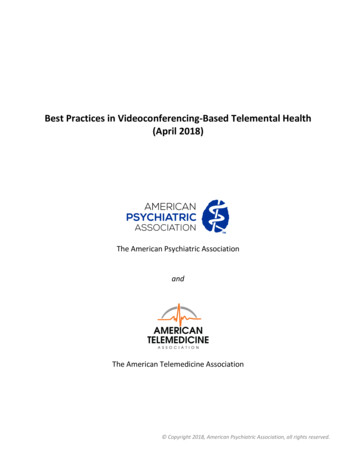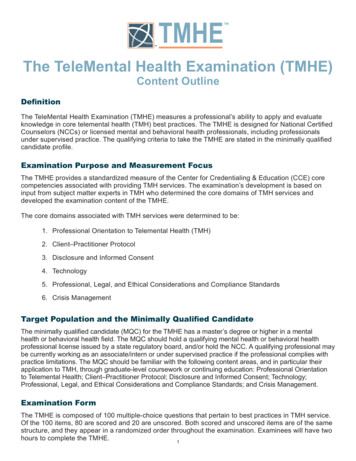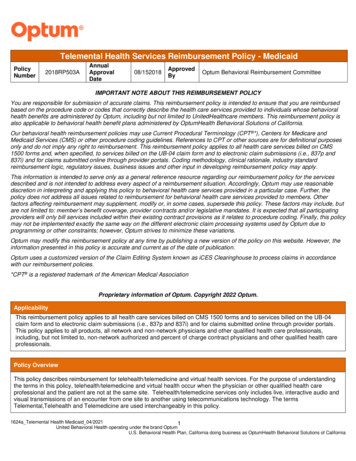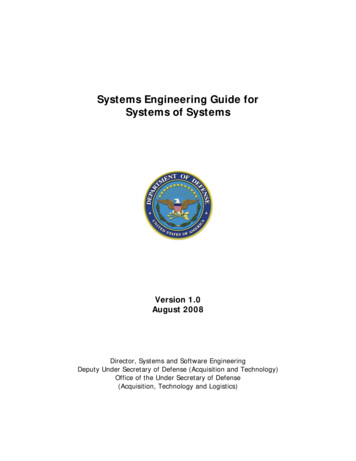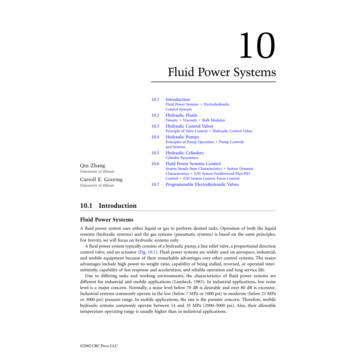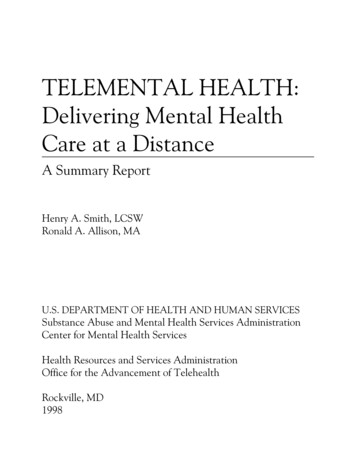
Transcription
TELEMENTAL HEALTH:Delivering Mental HealthCare at a DistanceA Summary ReportHenry A. Smith, LCSWRonald A. Allison, MAU.S. DEPARTMENT OF HEALTH AND HUMAN SERVICESSubstance Abuse and Mental Health Services AdministrationCenter for Mental Health ServicesHealth Resources and Services AdministrationOffice for the Advancement of TelehealthRockville, MD1998
This document was prepared by the authors under an Interagency Agreement between theSubstance Abuse and Mental Health Services Administration (SAMSHA) and the HealthResources and Services Administration (HRSA). The views expressed in this report are those ofthe authors and do not necessarily reflect the views of SAMHSA, HRSA, the Public HealthService or the Department of Health and Human Services.
FOREWORDThe provision of mental health services in America’s rural and frontier areas remains a criticalhealth services challenge. Telemental health - the provision of mental health services from a distance,using telecommunications technologies – is increasingly helping to surmount that challenge.This report is a joint effort of the Center for Mental Health Services, Substance Abuse and MentalHealth Services Administration (SAMSHA) and the Office for the Advancement of Telehealth, HealthResources and Services Administration (HRSA). It was produced to inform Federal, State and localmental health administrators about options for utilizing telecommunication and information technologiesto improve the delivery of mental health services to rural and frontier populations.Since the re-emergence of telemedicine programs in the late 1980’s, telemental health serviceshave consistently been one of the top three most frequently provided health services using telehealthtechnologies. In 1998-99, over 61 programs in 35 states were delivering telemental health services.Telemental health services are bridging the health services access gap not only for those who traditionallyhave had limited access to mental health services, in particular those in rural and frontier areas, but alsofor those who because of mobility problems, poverty, or incarceration have limited access to health careservices.Telemental health services are being delivered in a range of settings -- rural primary care clinics,hospital emergency rooms, community mental health centers, schools, and nursing homes. They are alsobeing delivered directly into homes as well as on board Navy ships and in jails, and state and federalprisons.Telemental health technologies are being utilized to provide the full range of mental healthservices, including pre-admission and discharge planning, assessments and evaluations, casemanagement, medication management, family visits, pyschotherapy, court commitment hearings, andfamily and consumer support groups. These technologies also provide a means to train mental healthproviders for rural practice. In some states, the one-year clinical internship of master’s level preparedsocial workers is supervised via telehealth technologies. The use of these technologies for continuingeducation and in-service sessions is also providing access to educational opportunities that have beenlimited in rural areas.Increasingly, state and local agencies responsible for mental health services are exploring the useof telehealth technologies to assist them in delivering services to rural and frontier populations andmeeting their mandates. Some have begun to invest in telehealth technologies or provide payment forservices delivered via telehealth. We hope that this report will assist policy makers, as well as mentalhealth professionals and consumers, as they explore how to effectively utilize these technologies,integrate the technologies into their practices, or advocate for their use to enhance access to services.Dena S. Puskin, Sc.D.DirectorOffice for the Advancement of TelehealthHealth Resources and Services AdministrationRADM Brian FlynnDirectorDivision of Program Development, SpecialPopulations and ProjectsCenter for Mental Health ServicesSubstance Abuse and Mental Health ServicesAdministration
PROJECT PARTICIPANTSThe Center for Mental Health Services and the Office for the Advancement of Telehealthgratefully acknowledge the contributions of the following project participants.Henry A. Smith, LCSW, Project DirectorThe Appal-Link NetworkCumberland Mountain Community ServicesP. O. Box 810Cedar Bluff, VA 24609Voice: 540-964-6702Fax: 540-964-5669E-mail: hsmith@cmcsb.comRonald A. Allison, MA, ProjectAdministratorThe Appal-Link NetworkCumberland Mountain Community ServicesP. O. Box 810Cedar Bluff, VA 24609Voice: 540- 964-6702Fax: 540- 964-5669E-mail: rallison@cmcsb.comCommittee MembersCathy Britain, Program ManagerRODEO NETEastern Oregon Human ServicesConsortium1100 K AvenueLa Grande, OR 97850Voice: 541-962-3430Fax: 541-962-3427E-mail: cbritain@orednet.orgNancy A. Cobble, RN, MA, ClinicalAnalyst – Information SystemsSt. Peter’s Hospital2475 BroadwayHelena, MT 59601Voice: 406-447-2742Fax: 406-447-2901E-mail ncobble@stpetes.orgClifford Hall, MD, Medical DirectorSouthwestern Virginia Mental HealthInstitute502 E. Main St.Marion, VA 24354Voice: 540-783-1226 (work)Fax: 540-783-1465E-mail: cthall@smyth.netThelma McClosky-Armstrong, DirectorEastern Montana Telemedicine Network2800 Tenth Avenue NorthBillings, MT 59102Voice: 406-657-4057Fax: 406-657-4875E-mail: tmcclosky@emtn.orgJim Reid, PA-CInnovative Medical Communications1013 Ridgewood CourtWest Des Moines, Iowa 50265-2042Voice: 515-314-8024Fax: 515-223-9389E-mail: jr@telemedprimer.comPamela Whitten, PhD, Assistant Professor,Telecommunications / Director ofTelemedical ServicesMichigan State University409 Communication Arts & SciencesEast Lansing, MI 48824-1212Voice: 517-432-1332Fax: 517-355-1292E-Mail: pwhitten@msu.edu
TABLE OF CONTENTSEXECUTIVE SUMMARY . iiiINTRODUCTION .1SECTION I:History and Recent Developments.3SECTION II:Telemental Health Services .8SECTION III:Selected System and Client Outcomes .14SECTION IV:Establishing a Telemental Health System.20CONCLUSION.29REFERENCES .30GLOSSARY .32
EXECUTIVE SUMMARYFor mental health care providers and consumers in rural and frontier America, the futureis now. Interactive telecommunication and information technologies make it possible for mentalhealth providers to literally be in two places at once, extending scarce resources to individuals,and to entire regions, that are medically underserved.Recent GrowthTelecommunication technologies have been used for some 40 years to provide limitedmental health interventions, mostly on an experimental basis. Beginning in the 1990s, however,the use of interactive telecommunication technologies flourished. The number of telemedicineprograms in the United States grew from nine in 1993 to over 100 in 1997, and most of themprovide mental health services. The seven most active telemental health projects in the nation,highlighted in this report, conducted approximately 70% of all the telemental health servicecontacts reported by the 50 most active projects in 1996.Substantial BenefitsThe range of mental health services provided to rural consumers over a telemental healthnetwork is virtually limitless. At the present time, it appears that all traditional mental healthservices, which do not involve direct physical contact with the client, can be provided bytelemental health. Telemental health networks are also used for education and training for mentalhealth staff, and to bring consumers and family members together for information and support.In some situations, telemental health services may be superior to face-to-face services.For example, telemental health allows a psychiatrist to observe a patient close up, withoutinvading his or her personal space. This makes it easier to examine a patient for side effects ofpsychotropic medications.Telemental health applications also enhance continuity of care for consumers in ruralareas. With telemental health, a “virtual treatment team” can be formed between the communityand the inpatient psychiatric facility staffs. Consumers can be followed in the community by thesame physician who treats them in the hospital, and family members can be involved intreatment and discharge planning.Positive OutcomesMuch of what is known about the impact of telemental health comes from the combinedexperience of staff and consumers who operate and participate in these networks. Though norigorous outcome studies have been done to date, informal findings suggest that telementalhealth improves continuity of care for rural consumers, increases family and consumerinvolvement in treatment, and reduces lengths of stays and readmission rates to state psychiatricfacilities. Participant satisfaction surveys reveal that consumers perceive telemental healthservices as worthwhile, of high quality, and worth continuing.iii
Organizational ConsiderationsThe introduction of telemedicine into a rural mental health care program requiresleadership, vision, and authority. Typically, there is a consortium of member sites, comprised ofdecision-making personnel, that meets on a regular basis to oversee the development,management, and growth of the network. This group identifies the consumers to be served,designs the clinical system, determines staffing levels, creates informed consent andconfidentiality procedures, and researches technological issues. Front-line staff meet to sharepractical knowledge and suggestions.Technology NeedsStart-up costs for a telemental health network are becoming more affordable due todecreasing equipment costs, and are therefore now within reach of most rural mental healthprograms. Indeed, in many cases, providers will find it more cost-effective to join a networkthan to purchase an automobile to transport mental health consumers to distant service providers.However, the single biggest limitation on the use, expansion, and long term sustainability oftelemental health systems is often the ongoing telecommunication costs.The type of telecommunication service(s) available from telephone companies willdictate network design and cost. In many rural areas, advanced transmission technologies orservices, such as Integrated Services Digital Network (ISDN), are not yet available. Also,transmission charges are often more expensive in rural areas because many transmission rates aredistance-based.The more advanced the transmission technology, the greater the bandwidth atelecommunications system will have available. Bandwidth refers to the information-carryingcapacity of the telecommunications channel (i.e., the size of the pipeline that carries the videoand audio signals). At higher bandwidths, picture and sound are transmitted more quickly andwith better quality. Lower bandwidth systems are more affordable, but they create noticeablelags in video and audio transmission that may negatively impact the service applications.FinancingOngoing expenses often prove to be a barrier to continued operation of a telementalhealth network. In response, many programs form alliances to gain a broader base of support,and network members share the costs for equipment, maintenance, personnel, and transmissionsystems. Federal, State, and private funds, and third-party reimbursement and service contracts,help sustain these vital efforts.Meeting the ChallengeTelemedicine, and in particular, telemental health networks, have the potential todiminish the disparity of mental health care based on population density characteristics.However, additional funding is needed to support research into the effectiveness of telementaliv
health programs, and to enable additional areas of the country to benefit from this new tool formental health service provision.v
INTRODUCTIONFor mental health care providers and consumers in rural and frontier America, the futureis now. Telecommunication technologies have been used for some 40 years in limited mentalhealth interventions, mostly on an experimental basis. Beginning in the 1990s, however, the useof interactive telecommunications technologies moved past the demonstration and experimentalphase into routine mental health service integration. It’s not an exaggeration to say that onemental health treatment specialist can now be in two or more places at the same time.Rural CharacteristicsTelemedicine, and in particular, telemental health networks, have the potential todiminish the disparity of mental health care based on population density characteristics. Ruraland frontier communities typically are the last areas to receive advances in mental health care,such as newer antipsychotic medications or specialized treatment programs.Funding of the public mental health care system is often based on population size, whichlimits the amount of money available to develop an adequate continuum of care in less populatedareas. Further, psychiatrists are usually located in urban areas, leading to a scarcity of servicesfor people with serious mental illnesses in rural communities.The use of telecommunication technologies to provide rural mental health services offersthe following benefits: extending scarce resources into geographic areas of service need,improving existing services, andcreating new services and applications that are unique products of the useof this technology.Today, not only is it possible to access a mental health care provider located in an urbancenter, but within a rural and frontier region, a telemental health network can unite groups andorganizations that have common goals and interests. These networks can be used to attractadditional resources from outside the region, as well as to expand the boundaries of therural/frontier mental health care village.Key DefinitionsMany of the key terms used throughout this report are defined in the Glossary. Severalare worth mentioning at this point. In particular, the term “telemedicine” refers to the use ofmodern telecommunication and information technologies to deliver health care services at adistance. “Telepsychiatry” is the specific application of telemedicine to psychiatry.A “telemedicine system or network” is an integrated health care network that usesmodern telecommunication and information technologies to provide comprehensive health care1
services to a specific group. When the system-wide influence of these approaches is considered,the term “telemental health” is used in this report.Telemental health has a broader mental health care systems meaning, and includes nonclinical applications, such as family and consumer support meetings, civil commitment hearings,case conferences, and prevention and education. A telemental health system uses interactivetelecommunication technologies to integrate, within a region, a comprehensive array of mentalhealth care services of related organizations.National Telemental Health LeadersThe number of telemedicine programs has grown from only nine in 1993 to over 100 in1997. Almost all telemedicine programs provide mental health services. In 1996, these servicesaccounted for nearly a quarter of all telemedicine consultations or sessions conducted.This report was produced primarily from the collective experiences of seven of the mostactive telemental health projects in the nation. These projects are the Appal-Link Network ofVirginia, The Menninger Center for Telepsychiatry (Kansas), the Eastern Montana TelemedicineNetwork, the University of Kansas Medical Center Telemedicine Services, RODEO NET(Oregon), VideoLink of St. Peter’s (Montana), and the Northern Arizona Regional BehavioralHealth Authority. These seven projects carried out approximately 70% of all of theclinician/patient telemental health service contacts reported by the 50 most active telemedicineprojects in 1996.The Summary ReportThis summary report explores, in brief, the applications, accomplishments, and benefitsof telemental health systems, particularly as they impact service delivery to people with seriousmental illnesses in rural and frontier areas. The summary addresses (1) the history oftelepsychiatry/telemental health and recent developments; (2) mental health services that are, orcould be, provided with interactive telecommunications; (3) selected client and service systemoutcomes of telemental health services; and (4) organizational, technological, and financialconsiderations involved in establishing a telemental health system.Full Text ReportReaders who would like to explore this topic in more detail are referred to the full reportTelemental Health: Delivering Mental Health Care at a Distance – A Guide for RuralCommunities, which is available from the Office for the Advancement of Telehealth, HRSA.(An updated Summary Report will be available Spring of 2002.)2
SECTION IHistory and Recent DevelopmentsFor the past 40 years, telemental health projects have increased access to needed servicesfor consumers in rural and remote regions of this country. Though early telemental health effortsused less advanced technologies and had limited applications, these projects paved the way forlater advancements by establishing several important principles.HistoryThe first documented use of telecommunications technology to provide health care at adistance occurred in 1920 at Haukeland Hospital in Norway, where radio links were establishedto provide health care support services to ships at sea. It wasn’t until the 1950s, however, underthe pioneering efforts of Dr. Cecil Wittson and his staff at the Nebraska Psychiatric Institute(NPI), that telemedicine was used in the field of mental health.The technology used by these early projects would be considered primitive by today’sstandards. The University of Nebraska designed a simple one-way closed circuit system usingsmall black and white televisions for lectures and instructional purposes. More than 1,000students at the Medical College of Nebraska received instruction via this network in the 1954-55academic year.The following year, the National Institute of Mental Health (NIMH) funded an interactiveaudio link connecting Nebraska Psychiatric Institute to seven hospitals in Nebraska, Iowa, andNorth and South Dakota. The Institute broadcast its weekly visiting lecturer series to the rest ofthe network and participants could ask questions to the lecturer in Omaha, allowing audienceinteraction with the site of origin for the first time.With continued Federal funding, the University of Nebraska program expandedthroughout the late 1950s and 1960s. Milestones included the first audio-visual interactivesystem in 1959, and the use of microwave technology to open a link in 1964 with Norfolk StateHospital, which was 112 miles away. This latter development meant that picture and soundcould originate from multiple locations at either site. In the late 1960s, the Nebraska projectlinked the Veteran’s Administration hospitals in Omaha, Lincoln, and Grand Island into theexisting network.In 1968, NIMH funded a project to develop a closed circuit link using two microwaverelay stations between the Department of Psychiatry at Dartmouth Medical School and a ruralhospital in Claremont, New Hampshire. The technology allowed for timely mental healthconsultation without moving the patient from his or her home environment. Also, for the firsttime highly trained technicians were not needed. Program staff, with limited technical training,could now operate these more “user-friendly” systems, eliminating the problem of down timedue to technical difficulties.3
In 1968, Dr. Thomas Dwyer expanded an existing telemedicine project at MassachusettsGeneral Hospital to provide emergency psychiatric consults to staff at Logan Airport MedicalStation in Boston, some 2.7 miles away. This project used a bi-directional televisiontransmission system equipped with remote camera control that allowed the consultingpsychiatrist at the hospital to pan, zoom, and focus the camera located at the remote site.This capability helped psychiatrists observe physical and emotional nuances withoutinvading an individiual’s personal space (Baer, Cukor and Coyle, 1997). In particular, doctorsreported that communication with adolescents, children, and certain patients with schizophreniawas easier than the conventional face-to-face interview process. For the first time, thetechnology was said to be more effective with these groups than the established “best practice”model.Lessons LearnedSeveral important lessons emerged from the early telepsychiatry projects. Mostimportant, consumers and physicians found the new technology both useful and comfortable.Further, these early projects tested some new applications that were found to be effective,such as psychiatric evaluations, family member visitations, and pre-discharge planning. Theyalso addressed potential roadblocks to widespread acceptance of telepsychiatry, including initialhesitancy of staff members to use the technology, technical problems such as sound pick-up andcamera operations in larger groups, and the high costs of equipment and transmission time.Without continued external funding, however, these projects could not maintain the highcosts of transmission and network support expenses. When Federal funding for these projectsended by the early 1970s, and third-party reimbursement options were not available, theprograms were forced to close.Recent DevelopmentsThe inauguration of telemedicine’s third generation began in the late 1980s. RenewedFederal funding, the rapid advancement of telecommunication and computer technologies, andthe introduction of managed care created opportunities to further investigate potentialapplications of this still-emerging technology. Seven current projects, and their key components,are outlined below.Current ProjectsOregon’s RODEO NET. The first of these third generation projects in the field ofmental health was Oregon’s RODEO NET. The Eastern Oregon Human Services Consortium inLa Grande received a three-year Rural Health Outreach grant in 1991 from the Federal Office ofRural Health Policy (ORHP), Health Resources and Services Administration (HRSA), DHHS.The grant enabled the Consortium to use a new statewide telecommunications system (Oregon4
ED-NET)--which offered the capability of video-conferencing via satellite and dial-up access tothe Internet--for the delivery of mental health services, training, and information. By providingscheduling, protocols, procedures, evaluation and training, RODEO Net became the interface forproviders to make use of the systems of the Oregon ED-NET.Because there are many locations throughout Oregon with limited telephone transmissiontechnology and access to the satellite network, RODEO NET broadened its reach byincorporating a mixture of satellite, microwave, and POTS (plain old telephone service)-basedtechnologies. By using this combination of technologies, RODEO NET has been able to expandits services, which include psychiatric consultation, case management, and medicationmanagement, to a larger number of rural Oregonians.The University of Kansas and the Menninger Center for Telepsychiatry. A study ofrural health care needs at the University of Kansas Medical Center led to the implementation in1992 of a state-wide interactive telemedicine network providing clinical and educational servicesfor residents throughout the state of Kansas. Residents at more than 20 sites throughout Kansas-from group homes to hospitals and jails--have access to more than 200 specialists at the MedicalCenter.The Menninger Center for Telepsychiatry in Topeka provides specialty consultationservices via this interactive network and manages the adult and child/adolescent units atProvidence Medical Center in Kansas City, Kansas, some 80 miles from the Menninger campus.The Menninger Center is also involved in distance learning and continuing education to otherpsychiatric and medical facilities across the nation.The Eastern Montana Telemedicine Network. The Eastern Montana TelemedicineNetwork (EMTN) began as a cooperative effort among health care providers to research thepotential of using two-way, interactive video conferencing technology to provide medical andmental health services throughout their region. Begun in 1993, EMTN has continued to expandits 11-site network providing a variety of clinical, educational, administrative, and communitydevelopment services to the region.A grant from the U.S. Department of Agriculture’s Rural Electrification Administration(REA), now the Rural Utilities Service (RUS), funded the equipment for the original five sites.A three-year Rural Telemedicine grant in 1994 from the Federal Office of Rural Health Policy,HRSA allowed EMTN to expand. Telemental health services are the leading medical applicationfrom a wide array of other specialty areas that make EMTN one of the more comprehensivenetworks in the nation.Northern Arizona Regional Behavioral Health Authority. In 1996, the NorthernArizona Regional Behavioral Health Authority (NARBHA) received funding from the ArizonaDepartment of Health Services to develop a telemedicine system to enhance the delivery ofbehavioral health services throughout northern Arizona. NARBHA contracts with a network ofcommunity-based agencies that provide behavioral health services to adults, children, families,and people with serious mental illnesses in a 62,000-square-mile rural area with a population of440,000.5
The system, NARBHA NET, uses advanced technology capable of delivering two-wayinteractive video and audio, tape recordings, and numerous computer applications. Twelve videoconferencing sites, including the Arizona State Hospital in Phoenix, participate, with at least fouradditional sites planned.Video Link of St. Peter’s (Montana). In 1994, the Federal Office of Rural HealthPolicy awarded a three-year Rural Health Outreach grant to St. Peter’s Hospital Foundation inHelena, Montana, to develop an interactive telecommunications system within the region.VideoLink of St. Peter’s (formerly Southwest Montana Telepsychiatry Network) serves a 12county, 28,509-square-mile area with a population of 190,000. The service area has a populationto psychiatrist ratio of 30,000 to 1.VideoLink uses two-way, interactive compressed video technology within the project’ssix-site network, which includes Montana State Hospital in Warm Springs and MontanaDevelopmental Center in Boulder. Collaboration with other existing networks has expandedaccess to 25 communities in Montana.The Appal-Link Network (Virginia). The Appal-Link Network was created to improveaccess to psychiatric care in rural and remote areas of southwest Virginia. Funded as a three-yearRural Health Outreach demonstration project by the Federal Office of Rural Health Policy,Appal-Link began operations in 1995. Appal-Link is the first telepsychiatry network in Virginiaand one of only six telemedicine networks in the nation dedicated exclusively to testingtelecommunications technology to deliver mental health services at a distance.Originally, the program served clients of the Cumberland Mountain Community ServicesBoard in Cedar Bluff who were hospitalized at the Southwest Virginia Mental Health Institute inMarion. Within two years, all of the community service boards in the Institute’s service areajoined the network. The telemental health system uses compressed video and audio transmissionover high-speed, enhanced telephone lines.Increased Access to Mental Health ServicesThough each telemental health project was developed to meet the specific needs of itsarea, they all were created to address a lack of mental health services, in general, and psychiatriccare, in particular, to rural areas. Some, such as the Kansas University Medical Center and theEastern Montana Telemedicine Network, offer a wide range of medical services, with telementalhealth being the primary application. Others, like Video-Link of St. Peter’s and Appal-Link, arededicated to mental health services and were developed to reach underserved populations.A Full Range of Services. The range of mental health services provided to ruralconsumers over a telemental health network is virtually limitless and includes all of the sameservices that can be provided in-person. These include the following (see the next section for amore complete description): patient evaluations,6
case management,medication management,crisis response,pre-admission and pre-discharge planning,treatment planning,individual and group therapy,family therapy,mental status evaluations,court commitment hearings,case conferences,family visits,family and consumer support groups,staff training, andadministrative activities.Substantial Benefits. The benefits of telemental health programs are substantial. Manypatients in remote regions, who are now being seen via a network, would otherwise have goneunserved, or they would have had to leave their home communities to receive care, often at greatcost to themselves or their families.In addition, telemental health networks provide continuity of care for rural clients byallowing the community treatment team to monitor their progress in the hospital and to beinvolved in discharge p
Increasingly, state and local agencies responsible for mental health services are exploring the use . Michigan State University 409 Communication Arts & Sciences East Lansing, MI 48824-1212 Voice: 517-432-1332 Fax: 517-355-1292 E-Mail: pwhitten@msu.edu . TABLE OF CONTENTS
